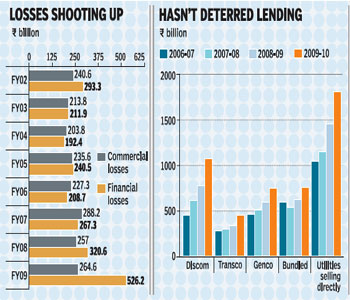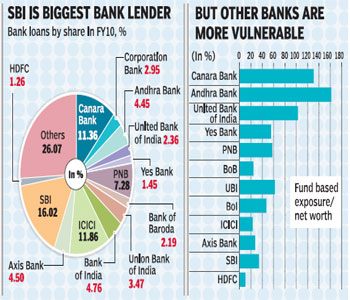Since banks were irresponsible in their lending to the power sector, they must be forced to pay the price
Given the pace at which NPAs are rising?in the last three years, restructured advances rose at around double the pace of credit growth?it?s not surprising the government is seriously worried about the impact of its proposed R2 lakh crore power sector bailout on the balance sheets of banks. The proposed three-year moratorium on interest payments would mean these loans would have to be classified as NPAs which would then surge beyond belief. As it is, ratings firm Crisil has upped its estimates of restructured assets for FY11 and FY12 to R3.25 lakh crore from R2 lakh crore just six months ago?much of the increase expected by Crisil is to come from power sector loans.
Which is why there will be a temptation to somehow convince RBI to grant one-time waivers which would allow banks to continue to classify these as standard assets. RBI, sadly, has allowed such waivers in the past. It has allowed banks to continue to classify Air India as a restructured asset instead of as an NPA and, last year, it allowed banks to lower their provision cover ratio as a higher ratio would mean that banks would have to report lower profits?SBI?s provision-cover-ratio is down from 68% in Q4FY12 to 64% in Q1, for instance. But in case RBI was to put up some resistance, the government?s line is likely to be a simple one, that this is a one-off event, unlikely to be repeated.




 RBI would do well to be wary of the argument since there was an equally big bailout around a decade ago and yet, the data shows, matters have only got worse, much worse. Commercial losses of state-owned power utilities have more than quadrupled over the last five years to an estimated R80,000 crore in FY12, and that?s after at least three reform packages in this period. A committee headed by Montek Singh Ahluwalia gave sweeping concessions to state utilities in 2001, the government has had an Accelerated Power Development and Reform Programme (APDRP) and even a Restructured APDRP?while outlays for the programmes have been over R50,000 crore, the actual amount sanctioned has been under R15,000 crore, suggesting states don?t have much of an appetite for even moderate reforms. The fate of a few billion dollars lent out by the World Bank linked to similar reforms has been equally dismal. That the losses are certain to rise again, and dramatically, can be seen from the big slippages we?re seeing?the average tariff-to-cost ratio for power was 82.2% in 1992-93 before falling to 67.8% in 1999-2000, and it then rose to 82.2% in 2006-07 but started falling after that, to around 78% today.
RBI would do well to be wary of the argument since there was an equally big bailout around a decade ago and yet, the data shows, matters have only got worse, much worse. Commercial losses of state-owned power utilities have more than quadrupled over the last five years to an estimated R80,000 crore in FY12, and that?s after at least three reform packages in this period. A committee headed by Montek Singh Ahluwalia gave sweeping concessions to state utilities in 2001, the government has had an Accelerated Power Development and Reform Programme (APDRP) and even a Restructured APDRP?while outlays for the programmes have been over R50,000 crore, the actual amount sanctioned has been under R15,000 crore, suggesting states don?t have much of an appetite for even moderate reforms. The fate of a few billion dollars lent out by the World Bank linked to similar reforms has been equally dismal. That the losses are certain to rise again, and dramatically, can be seen from the big slippages we?re seeing?the average tariff-to-cost ratio for power was 82.2% in 1992-93 before falling to 67.8% in 1999-2000, and it then rose to 82.2% in 2006-07 but started falling after that, to around 78% today.
Despite the mounting evidence that states were not doing anything to cut losses, however, the banks continued to fund the state power utilities as well as new high-cost projects in the private sector?since every unit of electricity generated adds to losses, and more so in the case of new high-cost plants, it?s not clear what the bankers who sanctioned these loans were thinking and what collateral they took to fund projects where the biggest risk was the solvency of the buyer. In fact, given the quantum of loans and how they were rising, it would appear the banks had their eyes shut even tighter than when they were converting loans from Kingfisher into equity at very generous terms. In the last five years, according to RBI, loans from banks?of the roughly R6 lakh crore outstanding loans of the power sector, roughly half are from banks?rose by 5.4 times, from R60,157 crore in FY06 to R3,28,900 crore in FY12.
 Though SBI is the largest lender and accounts for around 16% of lending to the sector, its vastly larger loan book means it is not the most leveraged?as a percentage of its loan book, power loans are just around 2%, but the figure is as high as 23% in the case of Canara Bank and 20% in the case of Andhra Bank (see graphic). Though banks are traditionally leveraged 8-9 times their net worth, it?s interesting to know that, for Andhra Bank the power sector loans are 1.6 times the net worth, and the figure is 1.3 times in the case of Canara Bank compared to around 0.3 times in the case of SBI?it would be worth examining the exposures of individual banks to individual SEBs to see if there is any violation of prudential norms here. Clearly, banks need to be asked to take a large part of this pain?it?s only when bank profits are hit that bankers will learn a lesson.
Though SBI is the largest lender and accounts for around 16% of lending to the sector, its vastly larger loan book means it is not the most leveraged?as a percentage of its loan book, power loans are just around 2%, but the figure is as high as 23% in the case of Canara Bank and 20% in the case of Andhra Bank (see graphic). Though banks are traditionally leveraged 8-9 times their net worth, it?s interesting to know that, for Andhra Bank the power sector loans are 1.6 times the net worth, and the figure is 1.3 times in the case of Canara Bank compared to around 0.3 times in the case of SBI?it would be worth examining the exposures of individual banks to individual SEBs to see if there is any violation of prudential norms here. Clearly, banks need to be asked to take a large part of this pain?it?s only when bank profits are hit that bankers will learn a lesson.
What?s also not clear right now is why the bailout is being planned. Since there are no large-scale power blackouts?a natural corollary were banks to refuse to finance power utilities any more?which would result in a citizen backlash across the country, the only pain point is the repayment of loans and interest to banks. But if state governments are not feeling the pain, what?s the guarantee they?ll do any reform after they are bailed out? While there are several suggestions, including getting states to privatise electricity in big cities before getting the bailout, there are problems with one-size-fit-all suggestions. Perhaps the best idea right now is to let states, and banks, remain in the pressure cooker for a while more, giving out short sums of money only against measurable reductions in financial losses, with the sanctioning of such loans outside the control of either banks or politicians?perhaps a CERC could be put in charge once pre-defined and unchangeable norms are decided upon.
sunil.jain@expressindia.com





















